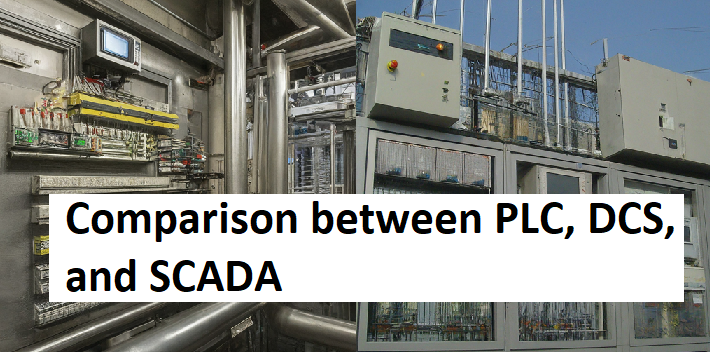Comparison between PLC DCS and SCADA – Learn about the differences between Programmable Logic Controllers (PLCs), Distributed Control Systems (DCSs), and Supervisory Control and Data Acquisition (SCADA) systems. Discover their unique roles, features, and applications in industrial automation.

PLC, DCS, and SCADA are three essential components of industrial automation systems, each with its distinct role and capabilities. While they often work together to control and monitor industrial processes, they serve different purposes and have varying levels of complexity.
Programmable Logic Controller (PLC)
A PLC is a ruggedized computer designed for industrial control applications. It’s primarily used for simple, discrete control tasks such as:
- Controlling machines and equipment
- Monitoring and controlling processes
- Implementing safety interlocks
- Executing sequential control logic
PLCs are typically programmed using ladder logic, a graphical programming language that resembles electrical relay logic. They are known for their reliability, robustness, and ability to operate in harsh industrial environments.
Distributed Control System (DCS)
A DCS is a more complex system than a PLC, designed to control large-scale industrial processes. DCSs are used for:
- Controlling continuous processes (e.g., chemical plants, refineries)
- Managing multiple PLCs and other field devices
- Providing real-time process monitoring and control
- Integrating with enterprise resource planning (ERP) systems
DCSs often consist of a network of interconnected controllers, communication buses, and human-machine interfaces (HMIs). They offer advanced features such as alarm management, historian capabilities, and sophisticated control algorithms.
Supervisory Control and Data Acquisition (SCADA)
SCADA systems are used to monitor and control industrial processes from a centralized location. They are typically used for:
- Collecting data from field devices (e.g., sensors, actuators)
- Visualizing process data in real-time
- Providing operators with a centralized view of the entire process
- Enabling remote monitoring and control
SCADA systems often integrate with PLCs and DCSs to provide a comprehensive solution for industrial automation. They can be used for various applications, such as power generation, water treatment, and transportation.
Key Differences
| Feature | PLC | DCS | SCADA |
|---|---|---|---|
| Primary Function | Discrete control | Continuous process control | Monitoring and control |
| Complexity | Low | High | Medium |
| Typical Applications | Machine control, safety interlocks | Chemical plants, refineries | Power generation, water treatment |
| Programming Language | Ladder logic | Function block diagrams, sequential function charts | Various programming languages |
| Integration | Can be integrated with DCS and SCADA | Often includes PLCs and other field devices | Integrates with PLCs and DCSs |
Conclusion
While PLC, DCS, and SCADA systems may seem similar at first glance, they serve distinct purposes within industrial automation. PLCs are ideal for simple, discrete control tasks, while DCSs are better suited for complex, continuous processes. SCADA systems provide a centralized platform for monitoring and controlling industrial processes. By understanding the unique capabilities of each system, engineers can select the most appropriate solution for their specific needs.
Home | Join us on Facebook, Twitter, YouTube, Instagram, Quora, Reddit, LinkedIn, Pintereset, Blogger.